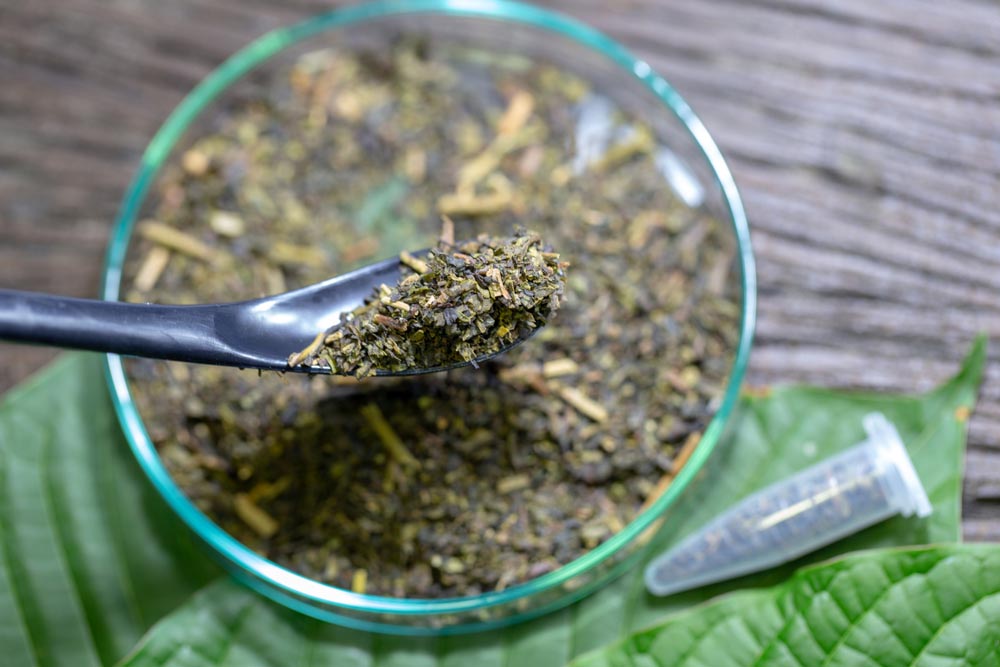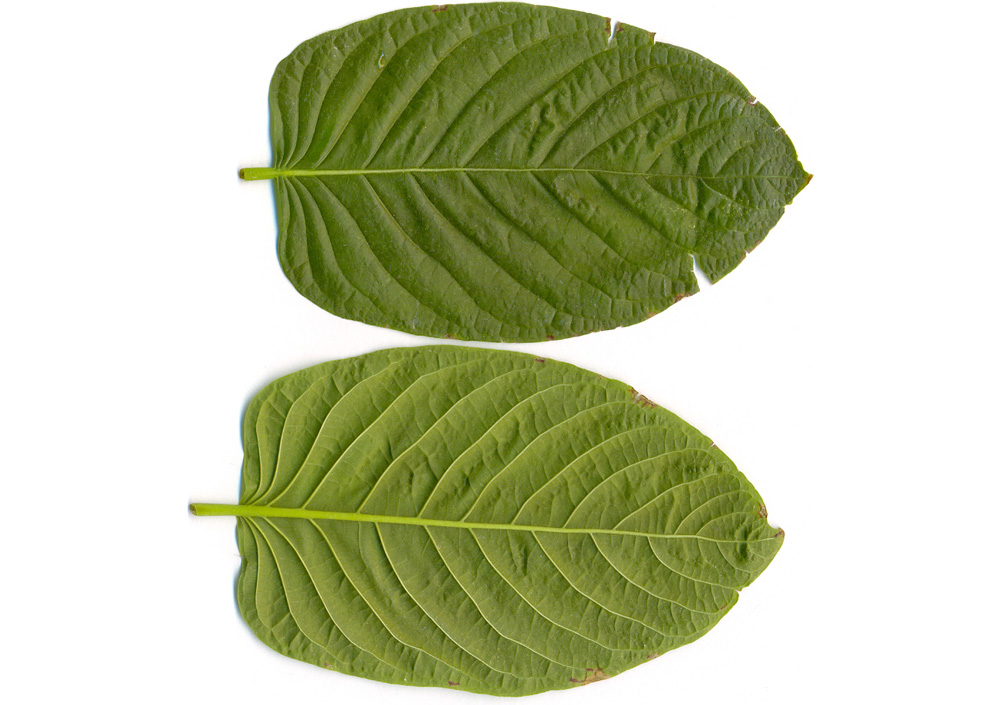The U.S. May Ban Kratom. But Are its Effects Deadly or Lifesaving?
Posted on Categories Discover Magazine

Kratom is a drug popular in Southeast Asia that’s derived from the leaves of Mitragyna speciosa, a tree in the coffee family. Kratom’s pain relieving properties allowed it to surge in popularity in the United States in the wake of the opioid crisis. (Rattiya Thongdumhyu/shutterstock)
Across America, thousands of people are throwing away their prescription drugs and picking up kratom, a plant-based drug from Southeast Asia usually brewed as a tea. Within the leaves of this tropical tree are opioid-like compounds that users say provide pain and anxiety relief, and the ability to wean off street drugs like heroin. But some health organizations warn kratom can be addictive itself or even deadly.
An estimated five million people use kratom regularly, according to the American Kratom Association (AKA), a pro-kratom lobbyist group. And the rising popularity of this herb has caught the eyes of federal government regulators, who have made several unsuccessful attempts to ban it. But that may soon change.
The Food and Drug Administration has blocked foreign kratom imports since 2015. And the Drug Enforcement Administration attempted to schedule kratom in 2016 — criminalizing it in the same legal category as heroin or marijuana — but stopped short in the face of unprecedented backlash from the public and congress members.
More recently, the FDA linked kratom to at least 47 deaths, suggesting the drug has high potential for abuse. However, the National Institute on Drug Abuse has emphasized that these deaths involved adulterated products or combining other drugs with kratom. In documents that were accidentally released this month, the Department of Health and Human Services also recommended a ban in October 2017.
“The adverse event reports underscore the serious and sometimes deadly risks of using kratom and the potential interactions associated with this drug,” an FDA spokesperson said in an email. “Kratom is an inherently addictive product that can cause harm, and it has no demonstrated medical benefit.”
A Kratom Ban?
But others have criticized the FDA’s interpretation of these reports, saying they do not reflect the science. And a ban would only make it harder for research to demonstrate any potential medical benefits.
“The FDA is using a database and a framework for reporting adverse effects that is not really designed to do an objective analysis of a death and determine what the cause of death was,” says Jane Babin, a patent lawyer and molecular biologist who has worked with the AKA.
Nonetheless, based on reactions from federal agencies, a ban is feared by those who use kratom and those who research it. A DEA representative recently told Business Insider that a ruling is imminent, but it’s still not clear when or what their decision will be, and kratom was noticeably absent from a recent DEA report on drug threats.
So what exactly is this herb, why is it so controversial, and what does the science say about its safety?

Kratom leaves are ground up and put into capsules or steeped in hot water for tea. (Manuel Jebauer/Wikipedia)
Life Saving Drug Or Deadly Narcotic?
There are many names for Mitragyna speciosa, a tree in the coffee family Rubiaceae, but kratom is the most familiar. Like coffee, a small amount of kratom can give you a stimulating buzz, while a larger kratom dosage can be more sedating. In its native Thailand, the plant’s leaves have been chewed or sipped as tea for at least 200 years, despite being outlawed by the government in 1943 during the Greater East Asia War.
Thailand, on the Japanese side, was fighting the U.S., and the war caused the cost of opium to skyrocket. (The region, the so-called Golden Triangle, was long notorious as the world’s largest heroin-producing hub, until Afghanistan later usurped the title.) Many Thai users switched from opiates to kratom, which was not taxed, so the government responded with a blanket ban.
Ever since, the Thai government has sent in troops to burn down kratom’s natural rainforest habitat, threatening other wildlife as well. More recently, Thailand’s president, Pornpetch Wichitcholchai, expressed support for a bill decriminalizing kratom and marijuana for medical research, which passed in early November.
The Kratom Market
It’s only in the last decade or so that kratom has become popular in the United States. Like cannabidiol, or CBD, a popular medicinal marijuana extract, kratom is typically sold in gas stations, smoke shops, and online, although some juice bars also serve it.
In 2016, the AKA and the University of Florida conducted an anonymous online survey of 8000 kratom users and found the majority were white, middle-aged, employed, and married. Two-thirds of respondents used the drug to self-treat pain and emotional or mental conditions. A smaller amount of people have used it to wean off opioids. Some researchers have also suggested kratom could have therapeutic potential, including antidepressant effects.
The rising number of kratom users has alarmed states like Vermont, Wisconsin and four others that have already banned the drug. Ohio may soon join that list, following a recommendation from the state’s Board of Pharmacy that kratom should be in a restrictive legal category alongside heroin.
Their report, issued in October, claims users are injecting kratom, which seems pretty unlikely to Babin given the amount of cellulose and other plant material typically in kratom products. “If you mix kratom with water, even adding heat, it’s not going to dissolve,” she says. The Board of Pharmacy did not respond to a request for comment.
The board’s statement reflects the FDA’s warnings of mortality and abuse potential, but a closer look at the FDA’s death toll has raised some eyebrows. Almost all of the 47 deaths cited involved the use of multiple drugs, meaning it’s not clear if they died from kratom or another substance. The FDA doesn’t point to any clear correlation between a known property of the botanical and the manner a person died.
In some cases, kratom products had been adulterated with opioids or other drugs. There is also a homicide, a suicide, and a case where a patient fell from a window and died from their injuries — but because kratom was found in the blood of the decedents, their deaths were included in the tally.
“In the case of the statements made by the FDA concerning kratom, it is my scientific opinion that they do not have appropriate evidence to support the conclusions,” says Paula Brown, the director of natural products research at British Columbia Institute of Technology. She has conducted a review of the botany, chemistry and ethnomedicinal uses of plants in the genus Mitragyna, as well as undertaken industry-funded research. Brown says in an email she does not believe the drug should be criminalized. “The import ban and negative commentary has forced this botanical into a gray or illicit market, where responsible procurement of material and manufacture is not seemingly a top priority.”
Babin agrees. Her first encounter with kratom began after hearing about chronic pain patients that were being involuntarily tapered off opioids. Their doctors were following aggressive prescribing guidelines issued by the Centers for Disease Control and Prevention in 2016.
The intent was to control the amount of deaths due to opioids, but the CDC later quietly admitted that deaths due to prescription drugs — as opposed to illicit fentanyl — were inflated by as much as 50 percent. Cut off from their prescriptions, many so-called “pain refugees” switched to kratom for relief from chronic pain.
“Between the FDA and the CDC, they’re narrowing what options people have,” Babin says, expressing concern that a ban will drive people to black markets. “Fentanyls are killing tens of thousands of people. If kratom is an alternative, it sure is one that is not, by anybody’s estimations, as deadly as the alternatives on the street.”
Unlocking Kratom’s Pharmacology
How The Kratom High Works
The abusive concern for kratom centers on two organic compounds called alkaloids contained within the leaves: mitragynine (MG) and 7-hydroxymitragynine (7-HMG). These two drugs show activity at μ-opioid receptors, which are related to pain relief. While these chemicals are not true opioids, they have demonstrated effective pain relief in human and animal studies.
These kratom chemicals may cause physical dependency, but most cases that researchers have documented portray withdrawals as fairly manageable, with pain and trouble sleeping described as the most unbearable symptoms. One study published this year in the Journal of Psychoactive Drugs noted, “these effects appeared to be relatively mild, since the majority of the participants did not seek treatment for their pain and sleep problems and, in fact, the withdrawal effects only lasted between one and three days.”
A rodent study published this year found that MG had little abuse potential and actually reduced self-administration of heroin in rats. Another recent rat study found the same result: MG did not have abuse potential and reduced morphine intake, whereas 7-HMG did have high abuse potential. Despite these opposing effects, about 60 percent of the alkaloids in kratom leaves are MG — only 2 percent are 7-HMG.
To understand what makes these two drugs unique, we need to talk about true opioids. When you take a drug like morphine, it interacts with μ-opioid receptors and brings in, or recruits, a protein called β-arrestin. This sends out chemical signals that can cause side effects like respiratory failure, which leads to deadly overdose.
Most opioids, including fentanyl, recruit β-arrestin, but MG and 7-HMG do not, meaning there is evidence that kratom has much less associated risks than opioids, including fatal overdose.
In other words, kratom may be slightly addictive, and it may have opioid-like effects, but based on the available science, it does not seem like kratom is as dangerous as heroin — or even close. However, without human clinical trials, which have yet to be done, it’s difficult to truly say.
Yet, the federal government’s moves to ban kratom have already made it difficult to study, as many researchers have protested. At least two human studies were cancelled following the DEA’s 2016 intent to ban kratom, and a Schedule I ban would likely make things more difficult to research, not less.
“If they force it underground, it’s not going to stop kratom from coming into the country,” Babin says. “It’s just going to be a bigger black box.”